Edmondia sesamoides
Edmondia sesamoides (L.) Hilliard
Family: Asteraceae
Common names: common everlasting (Eng.); sewejaartjie, strooiblommetjie (Afr.)
Introduction
Edmondia sesamoides is a perennial daisy with paper-like flowerheads which exhibit remarkable colour variation, ranging in colour from silvery-white to pale yellow to pink.

Description
Description
Edmondia sesamoides is a perennial shrublet, with a slender erect growth form up to 300 mm tall. Stems are thinly white-woolly and sparsely-branched. The leaves are dimorphic (with two different forms), at the base of the plant on the vegetative stems the leaves are very narrow and linear and 20–50 mm long, but on the flowering shoots they are short, 5–10 mm long, clasping and adpressed to the stem. Leaves have white hairs on the upper surface and are shiny and hairless below. Towards the tips of the flowering shoots the leaves give way to brown papery bracts and then to the solitary conical papery flowerheads which are ~25 mm long and ~50 mm across. Each flowerhead, called an inflorescence, has several closely overlapping papery bracts which resemble petals, surrounding a dense cluster of tiny yellow or brownish-yellow flowers. The bracts are narrowly pointed and range in colour from silvery-white to pale yellow to pink. Flowering is in late winter, spring and early summer (from August to December). Each flower produces a tiny cylindrical fruit topped by a tuft of pappus bristles.

Edmondia as a whole is often confused with the related genera Syncarpha and Helichrysum. The dimorphic leaves, long linear leaves at the base of the plants and short clasping leaves towards the flowerheads, distinguishes Edmondia from these related genera, where leaves are typically similar throughout the plant. Similarly, the leaves of Edmondia species are involute, with margins curled upwards, towards the top of the leaf whereas Syncarpha and Heliychrysum leaves are typically revolute, curled downwards, towards the bottom.
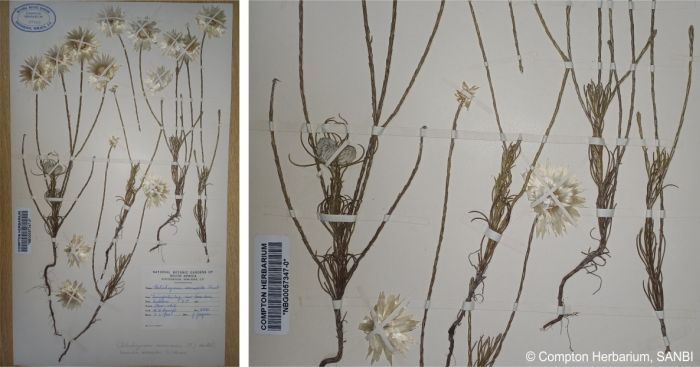
The genus contains only three species, Edmondia sesamoides, E. pinifolia and E. fasciculata which are easily confused. E. sesamoides differs from E. fasciculata by having brown scaly bracts only immediately below the head, whereas in the latter species these continue for 20–50 mm below the heads. It differs from E. pinifolia by having cylindrical as opposed to flattened fruits.
Conservation Status
Status
According to the Red List of South African Plants, the current (2020) conservation status of this species is assessed as Least Concern (LC).
Distribution and habitat
Distribution description
This species is endemic to the Western Cape of South Africa, where it grows from the Cederberg Mountains to Mossel Bay. It is a fynbos plant, and is known to grow on rocky flats and mountain slopes on dry sandy soils; in shrubby communities.

Derivation of name and historical aspects
History
This species was originally named by Carl Linnaeus in 1753 as Xeranthemum sesamoides. Edmondia was first recognised as a unique genus by Cassini in 1819, but this species has since undergone many changes in generic circumscription. As a consequence Edmondia sesamoides is most commonly known under the name Helichrysum sesamoides, before it was returned to the reinstated genus Edmondia by Hilliard and Burtt in 1981. None of the above authors provided reasons for either the generic name or species epithet, but we can assume that the genus name was derived from a historical collector named Edmond, possibly the Scottish botanist James W. Edmond (d. 1815). Similarly, the epithet sesamoides in Latin means ‘resembling sesame’, likely referring to shape of the seed-like fruits produced by the tiny flowers.
Edmondia belongs to the tribe Gnaphalieae in the Asteraceae, or daisy family. Asteraceae is the largest plant family, consisting of nearly 25 000 species worldwide and boasting a diversity growth forms; including herbs, shrubs and trees. The tribe Gnaphalieae, commonly known as paper daisies or everlastings, comprises about 1 200 species with a distribution concentrated largely in southern Africa and Australia.
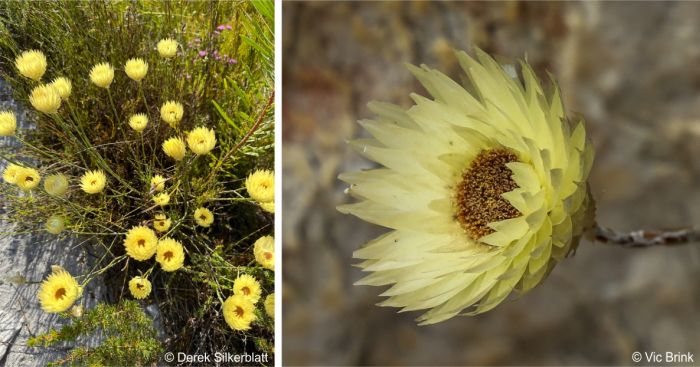
Ecology
Ecology
Edmondia sesamoides fruits are wind-dispersed, with each tiny fruit topped by a tuft of bristles which carries them away in the wind. Like other species of the everlastings of the tribe Gnaphalieae, fruits readily germinate in response to the smoke of veld fires, and can lie dormant for years untill a fire naturally arises, which clears areas of older shrubs allowing seedling to propagate. Like most fynbos plants, E. sesamoides plants do not do well when shaded out by taller plants, preferring open-canopy, sunny habitats.
Not much is known about the pollination of this species in particular, but other species in the Gnaphalieae are known to be pollinated by a diverse guild of insects, particularly flies and beetles, such as monkey beetles.
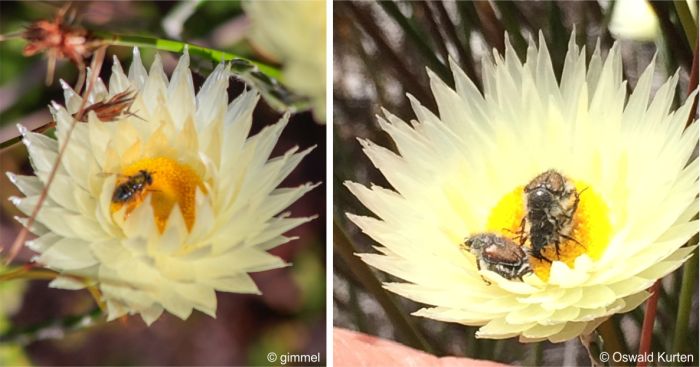
Uses
Use
There are no records of Edmondia sesamoides having medicinal uses, but the leaves of many species in the related genus Helichrysum are used medicinally by the people of southern Africa, in teas and mixtures for variety of medicinal purposes; including to treat sores and wounds, headaches, menstrual pain, coughs, colds and fever, as well as for magic spells.
Edmondia flowerheads are often used for dried floral arrangements or wreaths as their dry papery nature means they last indefinitely, hence the name ‘everlasting’.
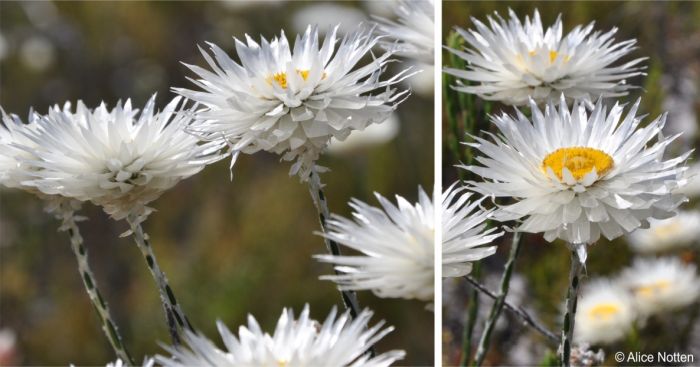
Growing Edmondia sesamoides
Grow
Edmondia sesamoides can be propagated by cuttings or by seeds. The soil medium should be sandy, well-drained soil which is slightly acidic. Cuttings should ideally be dipped in a rooting hormone prior to planting in early autumn. Seeds should sowed in early autumn as well, ideally in seed trays but can be sown directly in the soil. Lightly press seeds into soil and dust soil over the top. Like other South African daisies, seeds should be ideally be given a light dusting of fungicide to prevent fungal infection in seedlings. Seeds grow best when pre-soaked with a smoke extract for 24 hours. Seed trays can also be smoked after seeds are sown. Young plants can be pricked out from seed trays when the plants begin active growth in early spring.
Adult plants are hardy and should be cultivated in full sun, they will grow poorly when shaded by trees. They are drought-resistant and should thus not be overwatered, watering only when the soil is completely dry, and typically do not require fertilizer but will benefit from light applications of well-rotted compost applied as a mulch. Like other species of everlastings, this species is tolerant to light frost but should ideally not be grown in very cold gardens. The plants live for less than 10 years. They are ideal for fynbos gardens and fine additions to rock gardens, particularly coastal rock gardens. Due to their sparsely branched nature, they are not suitable as focal points in a display, but can be grown can along rocky walls or in mixed beds to provide bursts of colour.
References
- Brink, V. 2023. Observation of Edmondia sesamoides, Kleinmond, Western Cape. iNaturalist. Online. https://www.inaturalist.org/observations/192708786.
- Brown, N.A.C. & Duncan, G.D. 2006. Grow fynbos plants. Kirstenbosch Gardening Series. South African National Biodiversity Institute, Cape Town.
- Cassini, H. 1819. Synantherées. In Cuvier, G.-F (ed). Dictionnaire des sciences naturelles, 2nd ed., vol. 14. F. G. Levrault, Strasbourg & Paris; Le Normant, Paris.
- Eliovson, S. 1957. South African flowers for the garden. Cape Times Limited, Cape Town.
- gimmel. 2022. Observation of Edmondia sesamoides, Betty’s Bay, Western Cape. iNaturalist. Online. https://www.inaturalist.org/observations/141383201.
- Helme, N. 2021. Observation of Edmondia sesamoides, Swellendam, Western Cape. iNaturalist. Online. https://www.inaturalist.org/observations/100301444.
- Hilliard, O.M. & Burtt, B.L. 1981. Some generic concepts in Compositae–Gnaphaliinae. Botanical Journal of the Linnean Society 82(3): 181-232.
- Hilliard, O.M. 1983. Gnaphaliinae (first part): Facelis - Edmondia, Flora of Southern Africa 33(7),2: 1-317. Botanical Research Institute, Department Agriculture, Pretoria.
- Jackson, W.P.U. 1990. Origins and meanings of names of South African plant genera. University of Cape Town Printing Department, Cape Town.
- Kurten, O. 2023. Observation of Edmondia sesamoides, Noordhoek, Western Cape. iNaturalist. Online. https://www.inaturalist.org/observations/192845216.
- Lourens, A.C.U., Viljoen, A.M. & Van Heerden, F.R. 2008. South African Helichrysum species: A review of the traditional uses, biological activity and phytochemistry. Journal of Ethnopharmacology 119(3):630-652.
- Manning, J. & Goldblatt, P. 2012. Plants of the Greater Cape Floristic Region 1: the Core Cape Flora. Strelitzia 29. South African National Biodiversity Institute, Pretoria.
- Powrie, F. (ed) 1998. Grow South African Plants. A gardener's companion to indigenous plants. National Botanical Institute, Cape Town.
- Silberblatt, D. 2023. Observation of Edmondia sesamoides, Fernkloof Nature Reserve, Western Cape. iNaturalist. Online. https://www.inaturalist.org/observations/192654654.
- Studer, D. 2024. Observation of Edmondia sesamoides, Silvermine, Western Cape. iNaturalist. Online. https://www.inaturalist.org/observations/250273532.
- Van der Spuy, U. 1976. Wild flowers of South Africa for the garden. Hugh Keartlands Publishers, Johannesburg.
- Van Wyk, B.-E., van Oudtshoorn, B. & Gericke, N. 1997. Medicinal Plants of South Africa. Briza Publications, Pretoria.
- Von Staden, L. 2020. Edmondia sesamoides (L.) Hilliard. National Assessment: Red List of South African Plants. https://redlist.sanbi.org/species.php?species=3040-3.
Credits
Thaabiet Parker
Compton Herbarium, Kirstenbosch Research Centre
August 2025
Acknowledgements: images by Vic Brink, Nick Helme, Oswald Kurten, Alice Notten, Derek Silberblatt and Diana Studer.
Plant Attributes:
Plant Type: Shrub
SA Distribution: Western Cape
Soil type: Sandy
Flowering season: Spring, Early Summer, Winter
PH: Acid
Flower colour: White, Pink, Cream, Yellow
Aspect: Full Sun
Gardening skill: Average
Special Features:
Horticultural zones
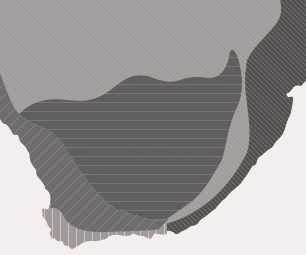







Rate this article
Article well written and informative
Rate this plant
Is this an interesting plant?
Login to add your Comment
Back to topNot registered yet? Click here to register.